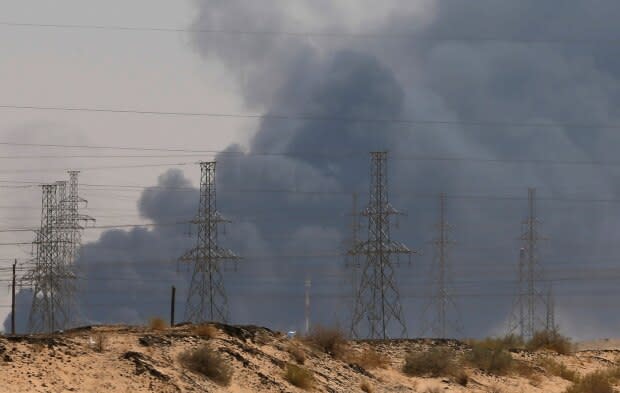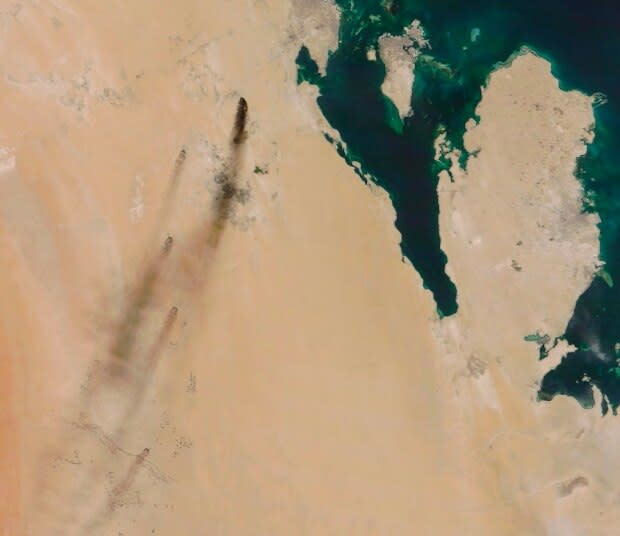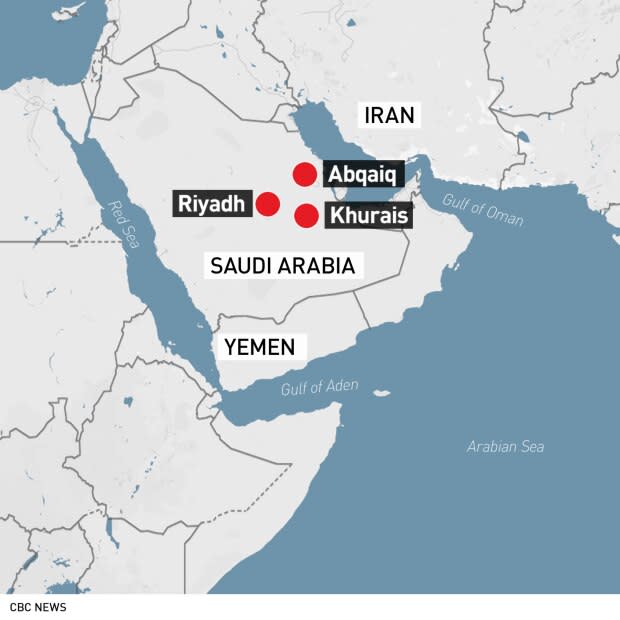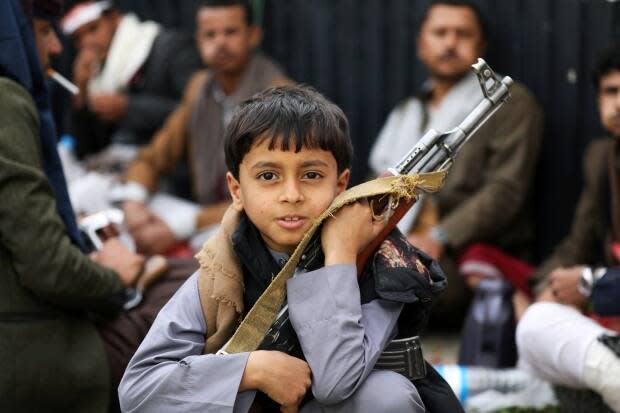Drone attack in Saudi Arabia hits world's largest oil processing facility
Drones launched by Yemen's Houthi rebels attacked the world's largest oil processing facility in Saudi Arabia and another major oilfield Saturday, sparking huge fires at a vulnerable choke point for global energy supplies.
The drone attacks affected up to half of the supplies from the world's largest exporter of oil, though the output should be restored within days, multiple news outlets reported and Saudi Arabia's energy minister Prince Abdulaziz bin Salman bin Abdulaziz later confirmed. He stated the country will make up for some of the loss with oil stocks, while the U.S. Energy Department released their own statement saying the U.S. "stands ready to deploy resources from the Strategic Petroleum Oil Reserves if necessary to offset any disruptions to oil markets."
In a statement released by the Saudi Press Agency, Prince Abdulaziz bin Salman bin Abdulaziz said explosions at Saudi Aramco's Khurais and Abqaiq plants caused several fires that were controlled, but there were no injuries.
Rising smoke from the fires at the sites could be seen by satellites in space.

First word of Saturday's assault came in online videos of giant fires at the Abqaiq facility, some 330 kilometres northeast of the Saudi capital, Riyadh. Machine-gun fire could be heard in several clips alongside the day's first Muslim call to prayers, suggesting security forces tried to bring down the drones just before dawn. In daylight, Saudi state television aired a segment with its local correspondent near a police checkpoint, a thick plume of smoke visible behind him.
The attack by the Iranian-backed Houthis in the war against a Saudi-led coalition comes after weeks of similar drone assaults on the kingdom's oil infrastructure, but none of the earlier strikes appeared to have caused the same amount of damage. The attack likely will heighten tensions further across the Persian Gulf amid an escalating crisis between the United States and Iran over its unravelling nuclear deal with world powers.
The Houthis, who hold Yemen's capital, Sanaa, and other territory in the Arab world's poorest country, took responsibility for the attacks in the war against a Saudi-led coalition that has fought since 2015 to reinstate the internationally recognized Yemeni government. But the U.S. blamed Iran, with Secretary of State Mike Pompeo tweeting, "There is no evidence the attacks came from Yemen."
"Iran has now launched an unprecedented attack on the world's energy supply," Pompeo added

In a short address aired by the Houthi's Al-Masirah satellite news channel, military spokesperson Yahia Sarie said the rebels launched 10 drones in their co-ordinated attack after receiving "intelligence" support from those inside the kingdom. He warned that attacks by the rebels would only get worse if the war continues.
"The only option for the Saudi government is to stop attacking us," Sarie said.
In a statement released Saturday, the UN's Special Envoy for Yemen Martin Griffiths called the attack "extremely worrying." They implored all sides to exercise restraint, and not "complicate the already fragile situation and jeopardize the UN-led political process."
The Special Envoy urges all parties to prevent such further incidents, which pose a serious threat to regional security, complicate the already fragile situation and jeopardize UN-led political process. - Martin Griffiths, UN Special Envoy for Yemen
Later, U.S. President Donald Trump called Saudi Arabia's Crown Prince Mohammed bin Salman to offer his support for the kingdom's defence, the White House said. The crown prince assured Trump that Saudi Arabia is "willing and able to confront and deal with this terrorist aggression," according to a news release from the Saudi Embassy in Washington.
The U.S. Embassy in Riyadh said it was unaware of any injuries to Americans. Saudi Aramco employs a number of U.S. citizens, some of whom live in guarded compounds near the site.

Saudi Aramco describes its Abqaiq oil processing facility in Buqyaq as "the largest crude oil stabilization plant in the world."
The facility processes sour crude oil into sweet crude, then later transports onto transshipment points on the Persian Gulf and the Red Sea. Estimates suggest it can process up to seven million barrels of crude oil a day.
The plant has been targeted in the past by militants. Al-Qaeda-claimed suicide bombers tried but failed to attack the oil complex in February 2006.
No immediate impact on oil prices
The Khurais oilfield is believed to produce over a million barrels of crude oil a day. It has estimated reserves of over 20 billion barrels of oil, according to Aramco.
Prince Abdulaziz bin Salman bin Abdulaziz said that according to preliminary estimates, 5.7 million barrels a day of oil production were lost, and the supply of ethane and natural gas also was cut by about half.
He said Aramco will provide updated information within 48 hours of restoring full production.
There was no immediate impact on global oil prices as markets were closed for the weekend across the world. Benchmark Brent crude had been trading at just above $60 US a barrel.

While Saudi Arabia has taken steps to protect itself and its oil infrastructure, analysts had warned that Abqaiq remained vulnerable. The Rapidan Energy Group, a Washington-based advisory group, warned in May that "a successful attack could lead to a months-long disruption of most Saudi production and nearly all spare production." It called Abqaiq "the most important oil facility in the world."
The Washington-based Centre for Strategic and International Studies separately issued its own warning just last month.
"Though the Abqaiq facility is large, the stabilization process is concentrated in specific areas — including storage tanks and processing and compressor trains — which greatly increases the likelihood of a strike successfully disrupting or destroying its operations," the centre said.
World's worst humanitarian crisis
The war has become the world's worst humanitarian crisis. The violence has pushed Yemen to the brink of famine and killed more than 90,000 people since 2015, according to the U.S.-based Armed Conflict Location & Event Data Project, or ACLED, which tracks the conflict.
Houthi rebels have been using drones in combat since the start of the Saudi-led war. The first appeared to be off the shelf, hobby kit style drones. Later, versions nearly identical to Iranian models turned up. Iran denies supplying the Houthis with weapons, although the UN, the West and Gulf Arab nations say Tehran does.
The rebels have flown drones into the radar arrays of Saudi Arabia's Patriot missile batteries, according to Conflict Armament Research, disabling them and allowing the Houthis to fire ballistic missiles into the kingdom unchallenged. The Houthis launched drone attacks targeting Saudi Arabia's crucial East-West Pipeline in May as tensions heightened between Iran and the U.S. In August, Houthi drones struck Saudi Arabia's Shaybah oilfield, which produces some one million barrels of crude oil a day near its border with the United Arab Emirates.
UN investigators said the Houthis' new UAV-X drone, found in recent months during the Saudi-led coalition's war in Yemen, likely has a range of up to 1,500 kilometres.
That puts the far reaches of both Saudi Arabia and the UAE in range.

 Yahoo Movies
Yahoo Movies 
